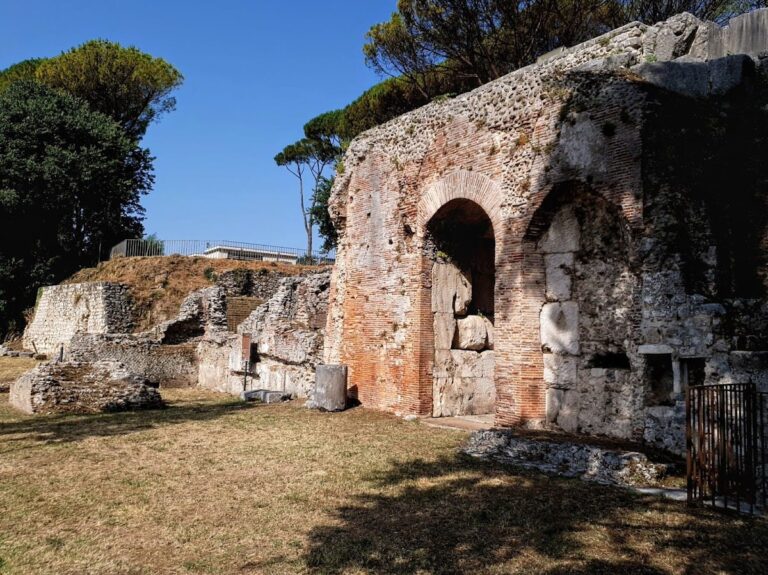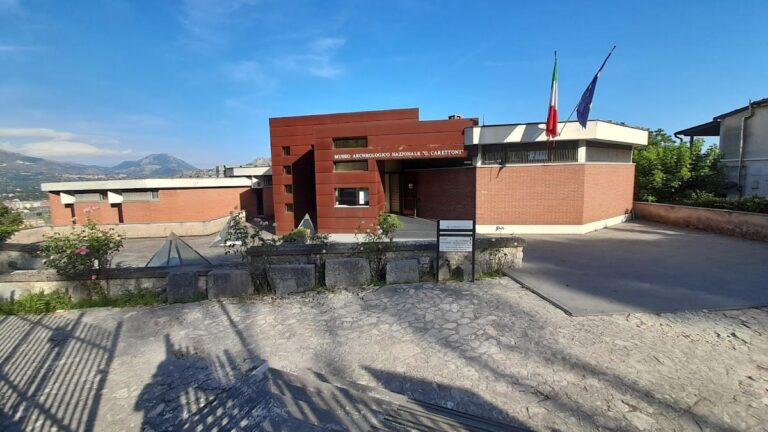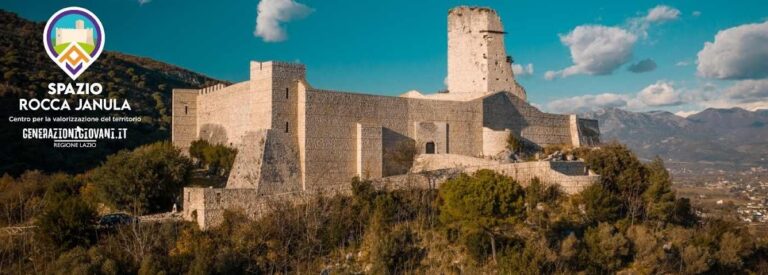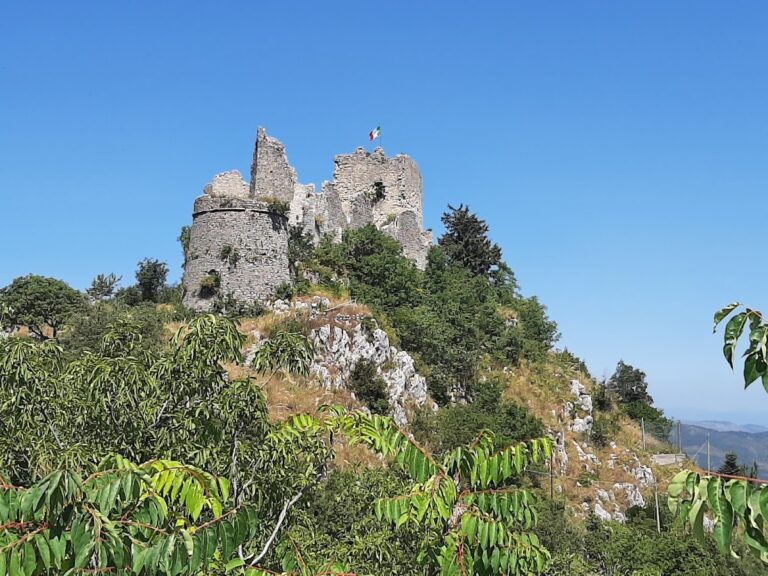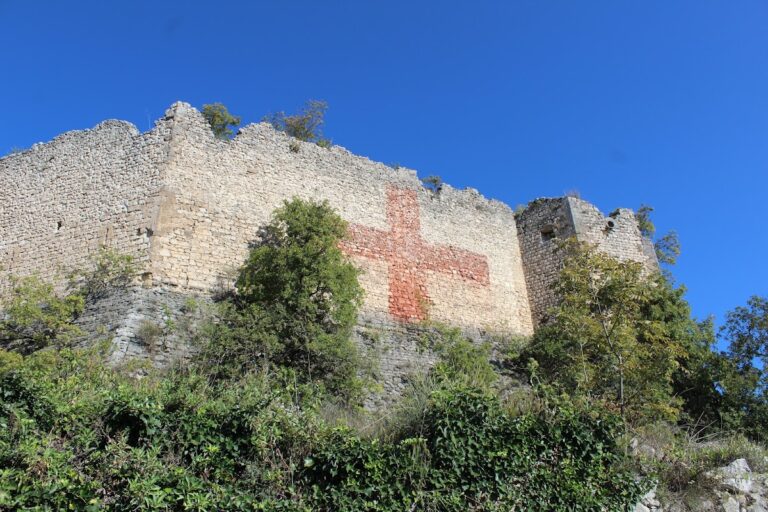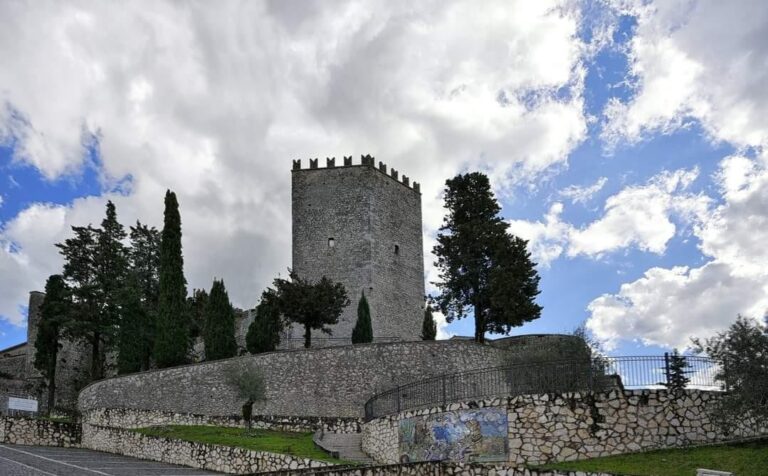Aquinum: An Ancient Roman Municipium in Italy’s Lazio Region
Table of Contents
Visitor Information
Google Rating: 4.6
Popularity: Very Low
Google Maps: View on Google Maps
Official Website: aquinum.wordpress.com
Country: Italy
Civilization: Roman
Remains: Burial, City, Civic, Domestic, Economic, Entertainment, Infrastructure, Military, Religious, Sanitation
Context
Aquinum is situated near the contemporary town of Castrocielo in the Province of Frosinone, within Italy’s Lazio region. The site occupies a commanding hilltop overlooking the Liri River valley, providing strategic elevation and extensive visibility over the surrounding landscape. Positioned within the foothills of the Apennine Mountains, Aquinum benefits from access to fertile alluvial plains and abundant freshwater springs, factors that have supported human settlement since prehistoric times.
The surrounding environment comprises a mixture of riverine lowlands and upland terrain, which historically facilitated diverse agricultural practices and shaped patterns of habitation. Aquinum’s location along the ancient Via Latina, a principal Roman road connecting Rome to southern Italy, further enhanced its regional connectivity. Archaeological evidence indicates continuous occupation from the Neolithic period through the Roman era and into late antiquity, reflecting the site’s enduring role within central Italy’s evolving cultural and political landscapes.
Systematic archaeological investigations initiated in the 20th century have uncovered a range of public and private structures, inscriptions, and artifacts. While some architectural elements remain visible above ground, others are known primarily through excavation. Conservation efforts have aimed to stabilize exposed ruins and support ongoing research, although portions of the site remain insufficiently explored, underscoring Aquinum’s potential for further archaeological discovery.
History
Aquinum’s historical trajectory encompasses its origins as a Volscian settlement, its integration into the Roman Republic and Empire, and its transformation during late antiquity and the medieval period. Its strategic position overlooking the Liri valley and along the Via Latina shaped its military, administrative, and economic roles. Over time, Aquinum evolved from a fortified Italic town into a municipium and later a colonia, reflecting broader processes of Roman urbanization and provincial governance. The site’s decline in late antiquity corresponds with the wider reconfiguration of central Italy amid the collapse of Roman authority and the emergence of medieval polities.
Pre-Roman and Volscian Period
Prior to Roman conquest, Aquinum was established by the Volsci, an Italic people inhabiting the region south of Rome. Archaeological and historical sources confirm Volscian control of the site into the early 4th century BCE. The settlement’s hilltop location overlooking the Liri valley provided a defensible position, which the Volsci successfully maintained against incursions by the Samnites, a neighboring Italic tribe. The toponym “Aquinum” derives from the Latin word for water, reflecting the numerous springs and water sources in the valley. Although human presence in the area dates back to the Neolithic, the Volscian foundation represents the earliest urban phase documented at the site.
Roman Conquest and Republican Era (4th–1st centuries BCE)
During the 4th century BCE, Roman expansion incorporated Aquinum into the Republic’s territory following campaigns against the Volsci. The city’s location on the Via Latina, a critical artery linking Rome to southern Italy, enhanced its strategic and commercial significance. By 211 BCE, Aquinum was granted the rare designation of “urbs,” a title previously reserved almost exclusively for Rome, indicating its elevated status within the Roman state. The destruction of the nearby town of Fregellae in 125 BCE further increased Aquinum’s regional prominence, establishing it as the principal urban center between Rome and Capua.
In the late Republic, Aquinum functioned as a municipium, as attested by Cicero’s writings, and was subsequently elevated to colonia status during the Triumvirate period in the late 1st century BCE. Architectural developments from this era include substantial limestone fortifications constructed under Augustus, a triumphal arch known as the Arco di Marcantonio featuring composite capitals, and the well-preserved Porta San Lorenzo, which controlled access along the Via Latina. Epigraphic evidence documents local magistrates and civic officials, confirming Aquinum’s administrative role. The city also exercised the right to mint its own coinage until the 3rd century CE, underscoring its economic autonomy within the Roman system.
Imperial Roman Period (1st–3rd centuries CE)
Throughout the Imperial period, Aquinum retained its status as a municipium within the province of Italia, sustaining its economic and administrative functions. Its position on the Via Latina continued to facilitate trade and production. The urban landscape included public amenities such as baths, a theatre, and an amphitheatre, reflecting the city’s municipal character. Several Roman villas have been identified in the surrounding territory, including one traditionally associated with the poet Juvenal. Aquinum is also considered the birthplace of the Roman Emperor Pescennius Niger.
Religious life during this period featured the worship of Hercules Liberator, evidenced by a temple dedicated to this deity. This temple was later superseded by the 9th-century Romanesque basilica of Santa Maria Libera, constructed over its remains. The city’s urban fabric comprised public, religious, and residential buildings arranged according to typical Roman municipal planning, indicating sustained urban vitality during the early Imperial centuries.
Late Antiquity and Christianization (5th–6th centuries CE)
By the mid-5th century CE, Aquinum had become the seat of a Christian diocese, reflecting the broader Christianization of the Roman world and the integration of the city into the ecclesiastical hierarchy. The 6th-century bishop San Costanzo emerged as the city’s patron saint, highlighting the growing religious significance of Aquinum. Following the death of Bishop Jovinus around 593 CE, the episcopal seat appears to have remained vacant, suggesting demographic decline or administrative reorganization amid the political instability of late antiquity.
Several early Christian churches were established, including the concattedrale di Aquino and others dedicated to San Costanzo and San Tommaso d’Aquino, indicating the persistence of religious activity. The gradual abandonment of Aquinum likely reflects the wider transformations affecting central Italy during this period, including shifts in settlement patterns and the decline of urban infrastructure.
Medieval Period and Norman Rule (12th century)
In the 12th century, Aquinum’s territory was incorporated into the Norman Kingdom of Sicily with the establishment of the county of Aquino. The Counts of Aquino controlled a castle in the area, including the Torre del castello dei Conti di Aquino, which functioned as a military and administrative center. This period saw the continuation of fortified and ecclesiastical architecture, such as the tower of San Gregorio Magno.
Although the renowned theologian Thomas Aquinas was born in 1225 in the nearby castle of Roccasecca, his family belonged to a collateral branch of the Counts of Aquino, linking the site to notable medieval aristocratic lineages. The medieval phase reflects Aquinum’s integration into the feudal and ecclesiastical structures of Norman southern Italy, marking a shift from its earlier urban prominence to a more rural, feudal context.
Daily Life and Importance by Period
Roman Conquest and Republican Era (4th–1st centuries BCE)
Following its incorporation into the Roman Republic, Aquinum developed as a municipium with a population comprising Roman settlers and indigenous Italic inhabitants. Epigraphic evidence attests to the presence of local magistrates, such as duumviri, who administered civic affairs. The economy was primarily agrarian, with cultivation of cereals, olives, and vineyards supported by the fertile Liri valley. Aquinum’s location on the Via Latina facilitated trade and the movement of goods.
Artisanal production, including ceramics and terracotta, likely occurred at household or small workshop scales. Dietary remains suggest a staple diet of bread, olives, wine, and fish, consistent with regional Roman practices. Clothing consisted of wool and linen tunics and cloaks. Domestic architecture featured mosaic floors and painted walls, with houses arranged around central courtyards containing kitchens and storage spaces. The Porta San Lorenzo regulated access to the city, reflecting organized urban planning. Religious life combined Italic and Roman cults, with temples and public buildings serving as centers for civic and religious activities.
Imperial Roman Period (1st–3rd centuries CE)
During the Imperial era, Aquinum’s population included Roman citizens, local elites, artisans, and slaves. Civic inscriptions document magistrates and officials overseeing urban governance. The economy remained agriculturally based but expanded to include villa estates producing olive oil and wine, some exhibiting luxury features. One villa is traditionally linked to the poet Juvenal, indicating a cultural milieu attentive to literary pursuits.
Dietary evidence confirms continued reliance on cereals, olives, and wine, supplemented by fish and seasonal fruits. Clothing adhered to Roman norms, with tunics and cloaks adapted to local climate. Archaeological remains of baths, a theatre, and an amphitheatre attest to active social and recreational life. Domestic interiors featured mosaics and frescoes, reflecting aesthetic preferences and social status. Markets supplied everyday and luxury goods, facilitated by trade along the Via Latina. Religious practices evolved, with the worship of Hercules Liberator prominent until the Christianization of the city. Aquinum’s role as a minting center until the 3rd century CE underscores its economic significance within the Roman provincial system.
Late Antiquity and Christianization (5th–6th centuries CE)
The establishment of the diocese in the mid-5th century introduced ecclesiastical governance alongside declining municipal structures. Bishops such as San Costanzo played prominent religious and social roles. After Bishop Jovinus’s death circa 593 CE, the episcopal seat’s vacancy suggests demographic decline or administrative reorganization. Christian churches, including the concattedrale di Aquino and others dedicated to San Costanzo and San Tommaso d’Aquino, became focal points for worship and community life.
Religious instruction and rites likely formed part of daily practice, though specific educational activities remain undocumented. The population probably contracted, with fewer urban amenities maintained; however, archaeological remains indicate continued occupation and religious continuity. Economic activities diminished but persisted on a reduced scale, with agriculture sustaining local needs. Trade and transportation declined due to regional instability. The transition from pagan to Christian practices altered social customs, emphasizing ecclesiastical authority. Aquinum’s civic role shifted from municipium to primarily ecclesiastical center amid late antique transformations.
Medieval Period and Norman Rule (12th century)
By the 12th century, Aquinum’s territory was integrated into the Norman Kingdom of Sicily as the county of Aquino. The population was smaller and more rural, organized under feudal structures controlled by the Counts of Aquino. The castle, including the Torre del castello dei Conti di Aquino, served as a military and administrative hub, reflecting the region’s strategic importance.
Daily life centered on agrarian activities, with peasants working the land under feudal obligations. Religious life remained vital, with churches such as the tower of San Gregorio Magno serving local communities. The Counts’ aristocratic household likely maintained a courtly culture, connected to broader Norman and Italian nobility. Trade and markets were limited compared to the Roman era, focusing on local goods and feudal dues. Transportation relied on horseback and footpaths through the Apennine foothills. Social hierarchy was sharply defined, with nobility, clergy, and peasantry occupying distinct roles. Aquinum’s importance had shifted from an urban municipium to a feudal territorial center within the Norman polity.
Remains
Architectural Features
The archaeological remains at Aquinum predominantly date to the Roman Republican and Imperial periods, with additional structures from late antiquity and the early medieval era. The city’s layout reflects a Roman municipium, comprising civic, religious, and residential buildings. Defensive fortifications include limestone city walls constructed during the Augustan period (late 1st century BCE), portions of which remain extant. These walls incorporate large ashlar blocks and feature several gates, notably the Porta San Lorenzo, which controlled access along the Via Latina.
Within the city perimeter, two temple remains survive, including one dedicated to Hercules Liberator. This temple was later overbuilt by the 9th-century Romanesque basilica of Santa Maria Libera, which currently stands roofless. Public entertainment and bathing facilities include a theatre and an amphitheatre dating to the Imperial period. Residential architecture is represented by several Roman villas in the surrounding territory, including one traditionally identified as the birthplace of the poet Juvenal.
Key Buildings and Structures
City Walls and Porta San Lorenzo
The city walls, constructed in the Augustan period, enclose the urban area with large limestone blocks. The Porta San Lorenzo, also referred to as Porta Romana in some sources, is a well-preserved gate through which the Via Latina passed. This gate features robust masonry and controlled the city’s main southern entrance. Adjacent wall sections remain visible, providing insight into the municipium’s defensive architecture.
Temple of Hercules Liberator and Basilica of Santa Maria Libera
One of the two temples within the city walls was dedicated to Hercules Liberator. The temple’s remains lie beneath the 9th-century Romanesque basilica of Santa Maria Libera, which is currently roofless. The basilica incorporates several Roman inscriptions into its structure, attesting to the site’s ancient significance. Its main portal features a mosaic depicting the Madonna with Child and two female founders of the church. The basilica is located near the southern city limits, close to the Arco di Marcantonio.
Arco di Marcantonio (Triumphal Arch)
The Arco di Marcantonio is a Roman triumphal arch dating to the second half of the 1st century BCE. Situated outside the city walls on the southern side near the basilica of Santa Maria Libera, the arch features composite capitals combining Ionic and Corinthian elements. The structure is well preserved and represents a significant architectural monument from the late Republican or early Imperial period.
Capitolium
Remains of the Capitolium, a Roman religious building likely dedicated to the Capitoline Triad, are present within the archaeological area. Although detailed architectural features are not fully documented, foundations and partial walls attest to its presence within the urban fabric, consistent with Roman municipal religious practices.
Theatre
The Roman theatre dates to the Imperial period and survives in partial form. Remains include sections of the seating area (cavea) and stage building. While detailed measurements are lacking, the theatre’s layout corresponds to typical Roman designs, with a semi-circular auditorium optimized for acoustics and visibility.
Amphitheatre
The site contains remains of a Roman amphitheatre from the Imperial period. The elliptical plan is discernible, though preservation varies. The amphitheatre was used for public spectacles and is situated within the urban area, contributing to the city’s entertainment infrastructure.
Public Baths
Foundations and fragments of hypocaust heating systems indicate the presence of public baths within the archaeological area. The layout suggests separate rooms for hot and cold bathing, typical of Roman thermal complexes, though preservation limits detailed reconstruction.
Roman Villas
Several Roman villas have been identified in the vicinity, representing rural residential estates. One villa is traditionally associated with the poet Juvenal’s birthplace. These villas exhibit typical Roman domestic architecture, including courtyards and service areas, though detailed descriptions are limited by excavation extent.
Other Remains
The archaeological area also includes medieval structures such as the Torre del castello dei Conti di Aquino, a castle tower belonging to the Counts of Aquino, and the tower of San Gregorio Magno. Foundations and fragments of earlier cathedrals are preserved, including Santa Maria degli Angeli (also called San Costanzo), a third cathedral near the tower of San Tommaso d’Aquino, and a fourth cathedral dedicated to Saints Costanzo and Thomas Aquinas. These remains extend into the territories of both Aquino and Castrocielo.
Archaeological Discoveries
Excavations and surface surveys have yielded numerous Roman inscriptions, many incorporated into later structures such as the basilica of Santa Maria Libera. These inscriptions document local magistrates, civic officials, and dedicatory formulas. Coins minted locally during the late Republic and Imperial periods have been recovered, including specimens studied in relation to the Angevin mint of Aquino.
Pottery fragments from various periods, including amphorae and tableware, indicate local production and trade connections. Domestic artifacts such as lamps and cooking vessels have been found in residential contexts. Religious objects include statuettes and altars associated with the worship of Hercules Liberator and early Christian dedications. Tools related to agriculture and crafts have also been documented, reflecting the settlement’s economic activities.
Preservation and Current Status
The preservation of Aquinum’s ruins varies. The Porta San Lorenzo and Arco di Marcantonio are among the best-preserved Roman structures. Portions of the city walls remain standing, though some sections are fragmentary. The basilica of Santa Maria Libera is roofless but retains significant architectural elements and mosaics. The theatre and amphitheatre survive in partial form, with structural remains stabilized but not fully restored.
Medieval remains such as the castle tower and ecclesiastical buildings survive as foundations and wall fragments. Conservation efforts have focused on stabilizing exposed ruins and preventing further deterioration. Some areas have undergone limited restoration using original materials, while others remain in situ without reconstruction. Vegetation and environmental factors continue to challenge preservation. Local heritage authorities maintain documentation and protection of the site.
Unexcavated Areas
Several parts of the ancient city remain unexcavated or only partially explored. Surface surveys and historical maps suggest buried remains in peripheral districts and agricultural zones surrounding the urban core. The full extent of residential quarters and economic installations has not been comprehensively investigated. Modern land use and conservation policies limit extensive excavation in some sectors.
Future archaeological work is planned to focus on underexplored areas, though no detailed excavation schedules have been publicly announced. Non-invasive methods such as geophysical surveys may assist in identifying subsurface structures. The site’s division between the municipalities of Aquino and Castrocielo affects research coordination and access.





